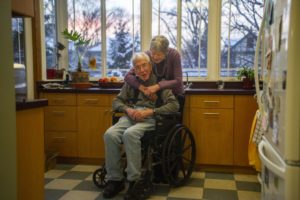How one Oak Park couple makes it work
by

John and Elisabeth Muhlenberg decided to remain in their home rather than opt for communal living, a decision that resulted in them making some main-floor alterations. | Alex Rogals/Staff Photographer
Elisabeth and John Muhlenberg have lived in their Oak Park four-square house since 1996. Elisabeth says of the 1910-era home, “It was, of course, built the way houses were built then. The first floor was for living, and the second floor had the bedrooms and bathrooms.”
At some point in its history, a previous owner carved out space for a powder room on the first floor. Elisabeth Muhlenberg notes that the half bathroom is “the size of a telephone booth and right off the dining room, which is not ideal,” but says the space worked for them for years.
The couple remodeled their kitchen in 2010 and were happy with the way their home lived, but then came a few unexpected obstacles. John’s Parkinson symptoms began to progress and his physical limitations made it too challenging to get up the stairs to use the shower in the second-floor bathroom.
With the arrival of the pandemic, the couple also determined that leaving their home for a communal living situation was no longer an option.
“The pandemic has convinced us that aging in place is the best solution for us.”
“The pandemic has convinced us that aging in place is the best solution for us,” Elisabeth said. “We can get out and have people come in and not be locked down.”
While the two embraced their decision to stay in their home, they knew they needed to address the lack of a shower on the first floor. Extending the powder room to create a full bathroom would have cut off space in the den, and they couldn’t figure out an approach that would keep their first floor functional. The couple had added a large closet to the family room during the kitchen remodel, but didn’t know if it would work as a separate shower space.
So they reached out to Tony Roeder of the construction company Marion Street Services. Roeder had worked on a project for the Muhlenbergs’ neighbors who were also looking to age in place in their Oak Park home.
Elisabeth Muhlenberg says seeing what their neighbors did with a similarly-aged home was inspiring.
“It was beautiful and intelligent work,” she said. “It let us know that we could do this.”
Roeder, who has been involved in the construction industry for roughly 40 years, says that he has experience with clients of a certain age who need to make changes to make their homes work for them in a new stage in life.
“We always end up at an intersection with our aging clients where we need to come up with solutions,” Roeder said.
He presented the Muhlenbergs with six different options. They say that Roeder took the time to walk them through all of the ramifications of putting a shower in different areas, including the costs associated with each option.
“Some of the options cost up to $35,000, which we did not want to spend,” Elisabeth said.
Roeder says that keeping costs in check is part of his job. He says that there are always areas that require money and those where savings can be implemented. At the end of the day, he says a solution can sometimes be found that costs less than the expense of a month in assisted living.
The Muhlenbergs chose the option of putting a shower into their large first floor closet, rather than attaching it to their powder room.
“The interesting thing is, it’s kind of temporary,” Roeder said. “It could be removed by the next owner of the home.”
He researched to find a pre-molded, ADA-accessible shower base, and lined the space in fiber-reinforced plastic on all four walls. Wood trim was replaced with PVC to make the room water tight.
Choosing a shower chair and deciding where to put grab bars are important decisions that Roeder says clients should weigh in on. While the Muhlenbergs originally thought they wanted a wall-mounted shower chair, he was able to find a few chairs for them to try through the Oak Park Township’s exchange program. They were able to determine that a freestanding chair was the best option.
In addition to design decisions, Roeder says that putting in new plumbing involves a lot of code issues, but he finds the village of Oak Park is willing to work on an unusual project like this. He says of Steve Cutaia, chief building official and ADA coordinator for Oak Park, “He met us there, and made sure we made it work.”
Cutaia says it is his job to work on all projects, even those that are outside the box.
“We’re always open-minded and always accommodating,” Cutaia said. “Permits are there for the homeowner’s protection to make sure whatever does get installed is checked by a few sets of eyes.”
Roeder states that he went through an aging transition with his own parents in the past and that he realizes there is a sensitivity to making changes like these.
“You need to meet people at these crossroads,” Roeder said. “This house is like a family member, and they want to be there.”
As the Muhlenbergs’ project was completed last week, John reports that having the shower has returned a sense of independence. Elisabeth says that feeling of independence was a motivating factor.
“You can age in place with a caregiver or someone helping, and you can cope with sponge baths,” Elisabeth said. “You can work around it, but it’s not a good solution. Seeing the work that Tony has done convinced us that this was the way to go.”
link to original article – https://www.oakpark.com/2022/01/27/aging-in-place-in-an-older-home/

